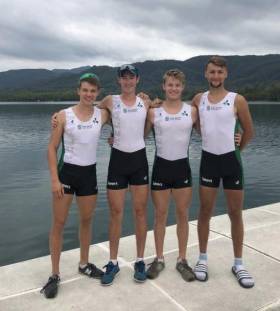Displaying items by tag: Andrew Goff
Ireland Lightweight Quad Fifth in the World
#Rowing: Ireland’s lightweight quadruple of Fintan McCarthy, Ryan Ballantine, Jake McCarthy and Andrew Goff took fifth in the A Final of the World Championships today. Germany raced well, winning a contest with Italy, who took second. Turkey, Ireland and Denmark fought it out for the bronze. The Turks took the honours, while Denmark’s fast finish pushed Ireland back to fifth in the world.
Men
Lightweight Quadruple – A Final: 1 Germany 5:51.21, 2 Italy 5:52.85, 3 Turkey 5:53.95; 5 Ireland (F McCarthy, R Ballantine, J McCarthy, A Goff) 5:56.64.
Double – Semi-Final One (First Three to A Final; rest to B Final): Britain 6:06.59, 2 New Zealand 6:08.00, 3 Romania 6:08.17; 5 Ireland (P Doyle, R Byrne) 6:10.95.
Women
Eight – Repechage (First Four to A Final): 4 Britain (8 R Shorten) 6:04.63.
Single Sculls – A/B Semi-Final (First Three to A Final; rest to B Final): 1 Ireland (S Puspure) 7:23.01, 2 Denmark (F-U Erichsen) 7:30.73, 3 Germany (A Thiele) 7:32.74.
Ireland Lightweight Quadruple Qualifies for World Rowing Final
#Rowing: Ireland’s lightweight quadruple of Fintan McCarthy, Ryan Ballantine, Jake McCarthy and Andrew Goff secured an A Final place at the World Rowing Championships in Plovdiv, Bulgaria, this morning. They took the second and final qualification place in their repechage. Turkey and Ireland showed they meant business right through the race, with only Algeria and then Norway showing signs of being able to upset this leading order. Turkey were excellent in the second half of the race, moving over a length clear of Ireland, who were content to find their way to the final.
World Rowing Championships, Plovdiv, Bulgaria, Day Four (Irish interest)
Lightweight Quadruple Sculls – Repechage One (First Two to A Final): 1 Turkey 5:51.12, 2 Ireland (F McCarthy, R Ballantine, J McCarthy, A Goff) 5:54.09
Ireland's Goff Secures Place in A Final of European Under-23 Champs
#Rowing: Ireland’s Andrew Goff has qualified for the A Final at the European Under-23 Rowing Championships. In beautiful calm conditions with a slight headwind in Kruszwica in Poland, the UCD man took a good second place behind Jan Cibuch of the Czech Republic. Goff started well and once Cibuch took over in the lead Goff stayed comfortably in touch. Sweden’s Filip Nilsson finished third.
European Under-23 Championships, Kruszwica, Poland, Day Two (Irish interest)
Men
Lightweight Single Sculls – A/B Semi-Final Two (First Three to A Final; rest to B Final): 1 Czech Republic 7:34.58, 2 Ireland (A Goff) 7:37.64, 3 Sweden 7:42.26.
Semi One: 1 Austria 7:32.69, 2 Turkey 7:34.45, 3 Slovenia 7:40.16

























































